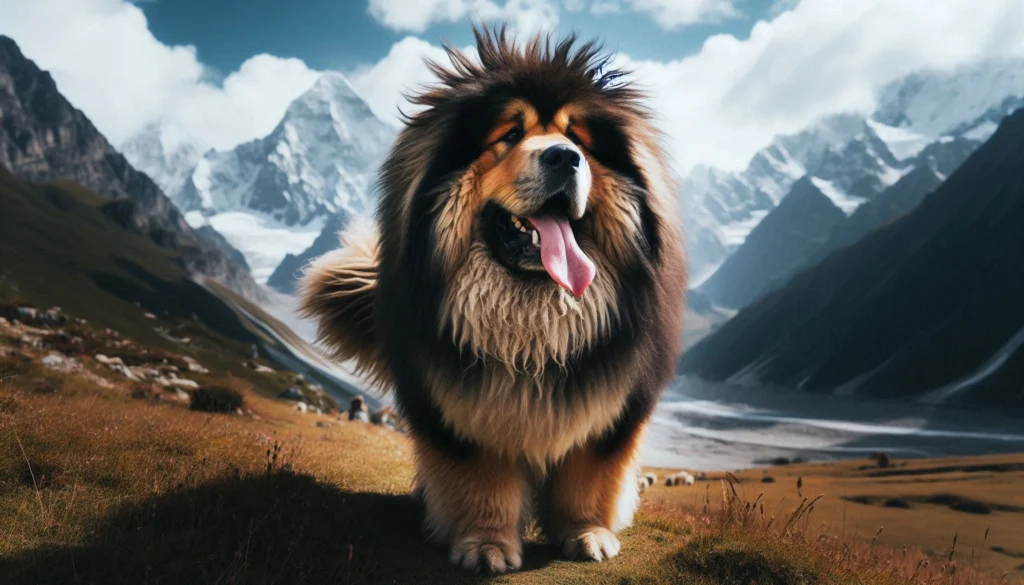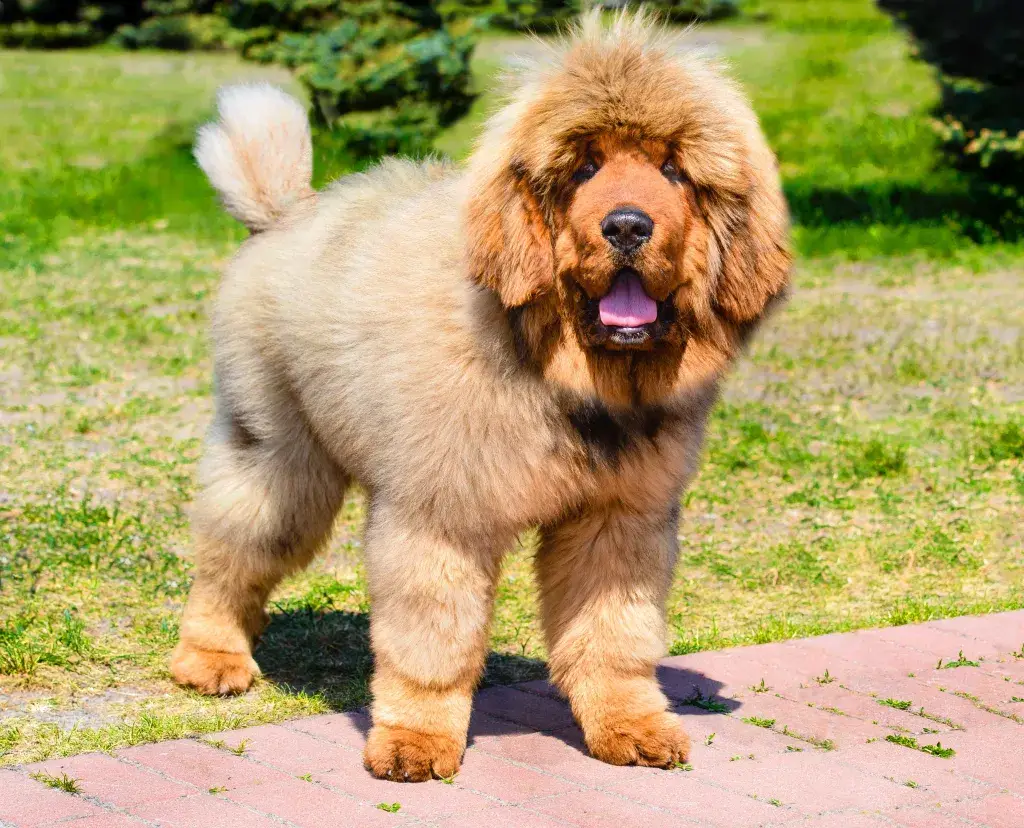Table of Contents
🐶 Tibetan Mastiff Dog Breed: History, Care and Characteristics
The Tibetan Mastiff is a majestic and powerful dog breed known for its imposing size, thick coat, and ancient lineage. Originating from the Himalayas, this breed has been guarding livestock and homesteads for centuries. With their noble appearance and protective instincts, Tibetan Mastiffs are becoming increasingly popular among dog enthusiasts. However, their unique characteristics make them a breed that requires careful consideration before bringing one into your home.
📜 Short History
The Tibetan Mastiff is one of the oldest and most revered dog breeds in the world. Its origins trace back thousands of years to the high-altitude regions of Tibet, Nepal, and Bhutan. Bred by nomadic cultures to protect flocks from predators like wolves and leopards, the Tibetan Mastiff’s role as a guardian is deeply ingrained in its temperament.
Historically, these dogs were also used to guard monasteries and villages, often working in harsh, remote environments. Their strength and resilience made them invaluable to the Tibetan people, who regarded them as sacred animals. The breed was relatively unknown outside of Asia until the 19th century when they were introduced to Europe by travelers and explorers. Since then, the Tibetan Mastiff has gained recognition worldwide, both for its impressive physical presence and its loyal, protective nature.
📌 Quick Facts & Essential Details

| Category 🏷️ | Details 📖 |
|---|---|
| 🐶 Breed Name | Tibetan Mastiff |
| 📛 Other Names | Do-Khyi (Tibetan), Tsang-Khyi |
| 📍 Origin | Tibet |
| 🏆 Recognized By | AKC, FCI, UKC, CKC & more |
| 📏 Size Variants | Standard (no mini or giant versions) |
| ⚖️ Weight Range | 70 – 150 lbs (32 – 68 kg) |
| 📐 Height Range | 24 – 30 inches (61 – 76 cm) |
| 🎂 Lifespan | 10 – 14 years |
🐕🦺 Coat & Appearance

| Category 🏷️ | Details 📖 |
|---|---|
| 🧥 Coat Type | Thick, double coat |
| 🎨 Coat Colors | Black, Brown, Red, Blue, Gold, Sable with possible tan markings |
⚡ Energy & Personality
| Category 🏷️ | Details 📖 |
|---|---|
| 🔋 Energy Level | Moderate – More active at night |
| 🏅 Breed Group | Working Group |
| 🐾 Temperament | Loyal, Independent, Protective, Reserved |
| 🏡 Apartment-Friendly? | No – Needs a large space |
| 🎓 Trainability | Moderate – Strong-willed & requires patience |
🏥 Health & Care Needs

| Category 🏷️ | Details 📖 |
|---|---|
| 💉 Common Health Issues | Hip Dysplasia, Hypothyroidism, Bloat, Eye Problems |
| 🛁 Grooming Needs | Moderate – Weekly brushing; heavy shedding seasonally |
| 🍂 Shedding Level | Seasonal – Heavy shedding twice a year |
| 🏃 Exercise Needs | Moderate – Daily walks & secure yard required |
🏡 Suitability & Compatibility

| Category 🏷️ | Details 📖 |
|---|---|
| 🏠 Best For | Experienced Owners, Large Homes, Rural Areas |
| 🚫 Not Ideal For | Apartment Living, First-Time Owners, Hot Climates |
| 🔊 Barking Level | High – Protective and territorial |
| 👶 Good With Kids? | Yes – With supervision, best for older kids |
| 🐕 Good With Pets? | Can be territorial, early socialization is key |
| 👩🏫 First-Time Owner Friendly? | No – Requires firm & experienced handling |
| 🌡️ Weather Tolerance | Excellent in cold weather, struggles in heat |
🎉 Fun & Extra Info
| Category 🏷️ | Details 📖 |
|---|---|
| 🌟 Famous Dogs of This Breed | Sold for $1.5 million in China as one of the world’s most expensive dogs |
| 🧠 Intelligence Level | High – Independent thinkers |
| 🐕 Common Behavioral Issues | Strong-willed, Stubborn, Guarding Instincts |
| 🥩 Best Diet | High-protein diet, raw or premium-quality kibble |
| 🚫 Foods to Avoid | Excess grains, Onions, Chocolate, Grapes |
| 🎈 Fun Fact | Tibetan Mastiffs were used to guard ancient monasteries against intruders |
| 💰 Price of Puppy | $2,000 – $10,000+ (Rare bloodlines can be extremely expensive) |
✅ Final Thoughts
The Tibetan Mastiff is a majestic, intelligent, and fiercely loyal breed best suited for experienced owners who understand their protective nature. With a rich history as a guardian dog, they require firm training, proper socialization, and a spacious environment. If you’re looking for a strong-willed but deeply devoted companion, the Tibetan Mastiff might be the perfect choice! 🏔️🐕
📊 Comparison of Similar Dog Breeds
🐕 Tibetan Mastiff vs. Bernese Mountain Dog 🐕


| Feature 🏆 | Tibetan Mastiff 🦁 | Bernese Mountain Dog 🏔️ |
|---|---|---|
| 📍 Origin | Tibet | Switzerland |
| 🏅 Recognized By | AKC, FCI, UKC | AKC, FCI, UKC |
| 📏 Size Variants | Large to Giant | Large |
| ⚖️ Weight Range | 70-150 lbs (32-68 kg) | 70-115 lbs (32-52 kg) |
| 📏 Height Range | 24-30 inches (61-76 cm) | 23-27.5 inches (58-70 cm) |
| ⏳ Lifespan | 10-12 years | 7-10 years |
| 🐶 Coat Type | Thick, dense double coat | Thick, long double coat |
| 🎨 Coat Colors | Black, brown, blue-gray, red, gold | Black, rust, and white (tricolor) |
| ⚡ Energy Level | Moderate | Moderate to High |
| 🏡 Breed Group | Working Group | Working Group |
| 🔊 Barking Level | High (territorial) | Moderate |
| 👶 Good With Kids? | Yes, but needs supervision | Yes, very affectionate |
| 🐕 Good With Pets? | Can be reserved | Generally friendly |
| 🧠 Intelligence Level | High (independent thinker) | High (eager to please) |
| ⚠️ Common Behavioral Issues | Strong-willed, territorial, stubborn | Separation anxiety, excessive shedding |
| 💰 Price of Puppy | $2,000 – $10,000+ | $1,500 – $3,500 |
| Overall Rating | ⭐⭐⭐⭐ (for experienced owners) | ⭐⭐⭐⭐⭐ (family-friendly) |
Conclusion
The Tibetan Mastiff is a breed like no other, combining ancient lineage with a powerful presence and a loyal heart. While they require a dedicated and knowledgeable owner, those who invest the time and effort will be rewarded with a devoted companion and an exceptional guardian. If you’re considering adding a Tibetan Mastiff to your family, make sure to do thorough research and prepare for the responsibility that comes with such a noble breed.
FAQ
Is the Tibetan Mastiff a dangerous dog?
The Tibetan Mastiff is not inherently dangerous, but their protective instincts can make them wary of strangers. Proper training and socialization are essential to ensure they can distinguish between real threats and everyday situations.
Is the Tibetan Mastiff the best guard dog to protect my family?
Tibetan Mastiffs are exceptional guard dogs due to their strong protective instincts and loyalty. They will fiercely protect their family and home, but they require an owner who can manage their territorial behavior through training and socialization.


